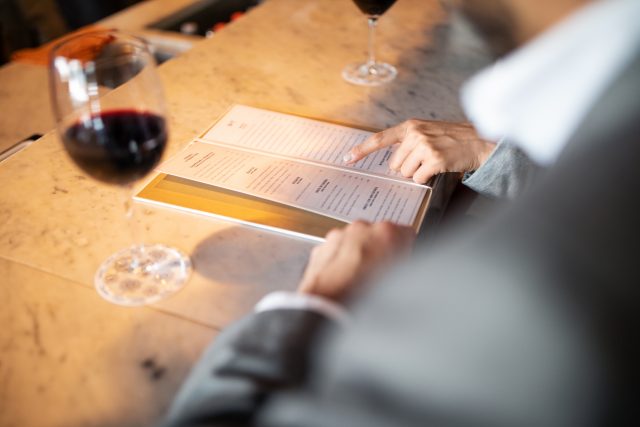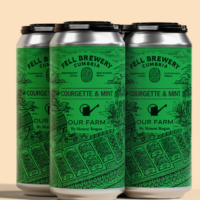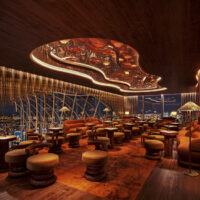Here’s a handy list of insider information on why wines get marked up and how to get the best deals and service when ordering.

Ever perused a wine list knowing that you’d have paid a fraction of the price at the supermarkets had you selected a bottle of seemingly similar wine? Ever wondered what is really worth spending a bit more on when you’re out? Well, it seems you’re not alone. For the curious among you, EBT has gathered thoughts of experts in the trade to supply you with seven top tips when ordering wine while out dining.
1. The highest priced bottles have the lowest markups.
If you are determined not to pay more than £25 for a bottle of wine, you might be missing a great deal, said Mark McDonald, chef and co-owner of Old Vibe Kitchen & Bar in Costa Mesa. “Sometimes it can take a year or more to sell 12 bottles of £150 wine,” he explained. “Typically if I did a standard markup on that it wouldn’t be approachable and it would be harder to sell. We want people to experience some of these wines that are a little more special, and that are a higher price point. So we take less of a margin on those.”
2. Wine by the glass has the highest markups.
The “I’m going to save money by having just one glass” plan doesn’t always work out as cost-effective. After all, many restaurants charge the same or nearly the same price for a glass as they would for the bottle. That’s because if they serve one glass and the rest of the bottle doesn’t sell in a week, it will not be at its best, unless they’re using a Coravin or similar, and therefore they’ll have to throw it out anyway.
The per-glass price of a bottle that’s £10 wholesale would be £12. Even if it’s only marked up double £20 when it’s sold by the bottle, you buy two glasses of wine, and you’re spending £24. Might as well buy the bottle and get four glasses for £20.
Lawry’s Restaurants solved that problem by narrowing down its by-the-glass selection. “We did some analysis on it. If you have the right amount of wine by the glass for the restaurant, it really doesn’t cost any more,” said Laura Ratner, director of service and training at Lawry’s Restaurants Inc. “It’s like, if I’m gonna have a glass and a half, two glasses, as is my dining companion, then definitely get the bottle and yes, you’re more assured of a higher quality product, you know exactly how long it’s been open. It just makes more financial sense.”
3. It’s useless to look for that supermarket bargain in a restaurant.
As the biggest retailers, they can afford to lose money on some bottles. “Guests say, ‘We have this…, we just got it at Costco. And their price was this.’ They don’t understand,” said William Lewis, managing partner and sommelier of The Winery Restaurant & Wine Bar. “They undercut prices on purpose. They do that to get you to come in. And they know you’re gonna buy something else. You’re gonna get food. You’re gonna get this. You’re gonna get that. You’re not gonna just go and get one bottle of wine.”
4. The wine service you get at a restaurant can’t be replicated at home and that’s why you’re paying extra.
A. It is a fact that most restaurant wines come directly from wineries or a trusted distributor. Bottles don’t sit around at room temperature on supermarket shelves, or worse, out in the sun on a loading dock. They’re pristine because they’re stored at the restaurant, often in temperature-controlled areas, which is part of the restaurant’s footprint and therefore part of the rent they pay.
B. The selection is always going to be heaps better than the average person could own or store themselves, sometimes with hundreds of bottles or more. That’s why restaurants have well-trained staff, sommeliers and general managers on hand to answer any questions about the wine and to hear from you about what kinds of wines you like best. Most good restaurants will have made sure their team attend wine tastings at work led by experts from distribution companies or wineries.
C. The glassware has to be sturdy, yet crystal clear to show off the wine and the restaurant picks up the cost of the breakage. They might only break one a week, but sometimes a whole tray or dishwasher rack hits the floor. When fine dining rooms use fancy, fragile glasses, they could be losing a dozen a week. In most restaurants, when the wine list gets revamped, the glassware also receives an upgrade.
“We changed the glassware to be a more contemporary stemless glass. We pour it behind the bar into a nine ounce carafe. Then at the table, we present it to them,” said Eric Stenta, vice president of operations at Polly’s Inc. who said the restaurant group did not even offer wine for 40 of the 52 years it has done business. “We had glasses that were way too small and we were overfilling them. The wine drinkers at Polly’s began to get accustomed to overfilled glasses. So when we went from an eight ounce glass to a 16 ounce glass, to prevent people from thinking that they were being under poured, we put it in the carafe. So, we got the best of both worlds, a better presentation and a better glass.”
5. Don’t think you’re paying a sommelier’s salary.
Starting in the late ’80s, the number of people getting sommelier-certified saw an uplift. Fine dining restaurants at the highest levels still might have somms, but most restaurants, even upscale chains, can’t afford to pay a somm full-time so that expense is not getting passed on to wine buyers. Most often restaurants require waiters and general managers to study wines served and/or get some sommelier training.
“We can’t afford to pay somebody hourly to come in just to open wine between six and nine o’clock, it doesn’t make sense,” said Lewis. “I’m like an acting GM. I do the wine service. I’ll open wine all day long.”
6. The most popular wines are sold at the lowest prices.
Restaurants won’t excessively mark up a well-known wine. “Don’t forget, people now have their iPhones when they’re going to a restaurant,” said Tony Maalouf, restaurant manager at the Mission Inn Hotel & Spa in Riverside. “They have an idea what they’re buying and they know what the market price is for that wine,” he said.
7. Corkage fees: Remember the rules of engagement.
Bringing your own wine has become more common in some venues aiming to keep overheads down, especially during and post pandemic. But we often need to remember in these instances that wine is the only thing on the menu for which you can name your price. Remember, if you bring your own wine then it’s only courteous to show up with something that’s not already on the wine list, especially a bottle you’ve been saving for a special occasion. It’s also considered a nice gesture to offer the server a taste. After all, politeness doesn’t cost a thing.




